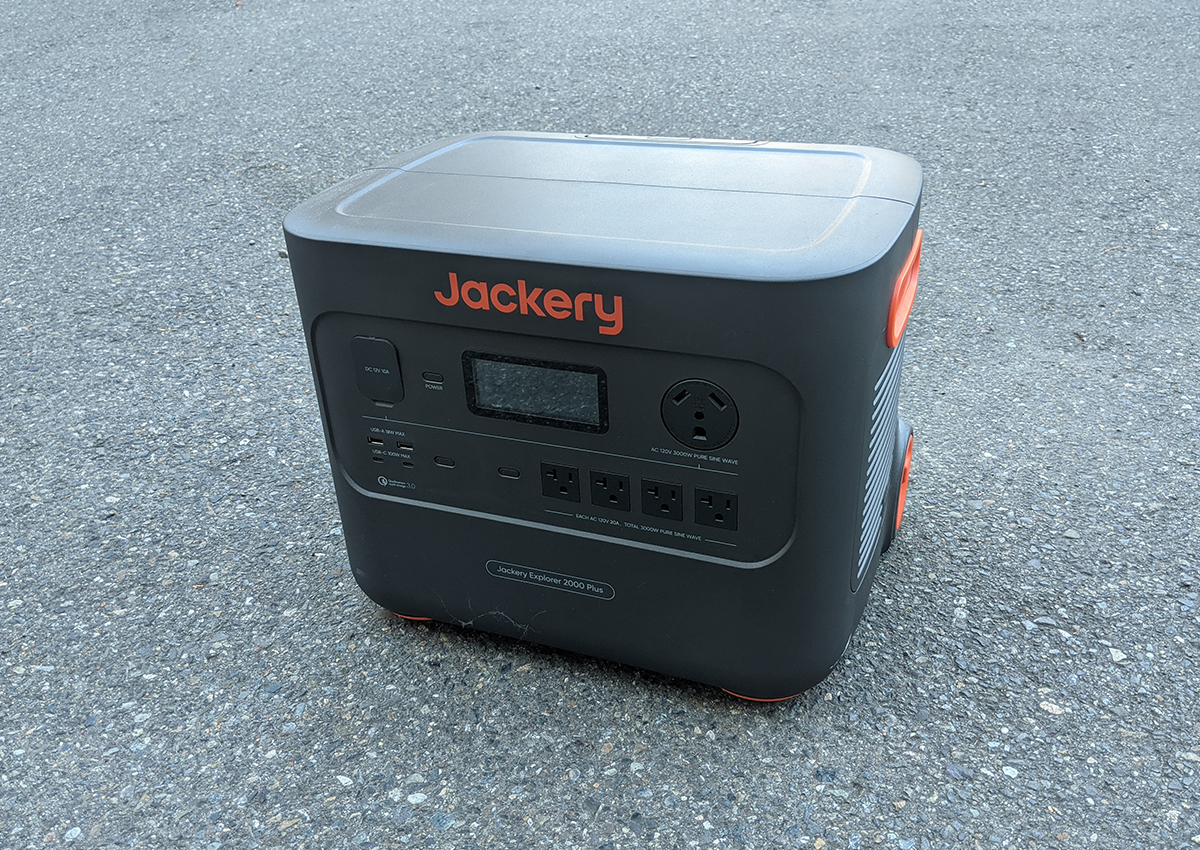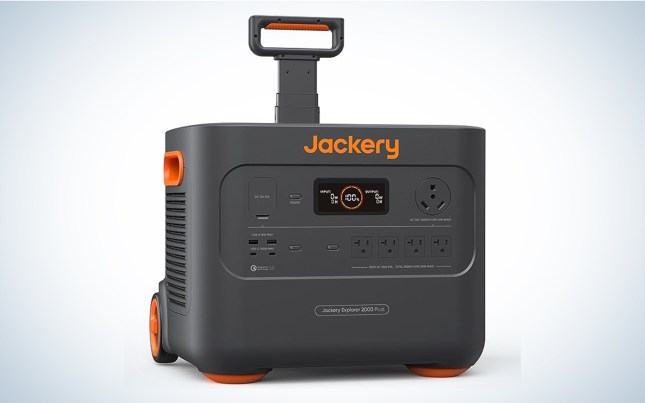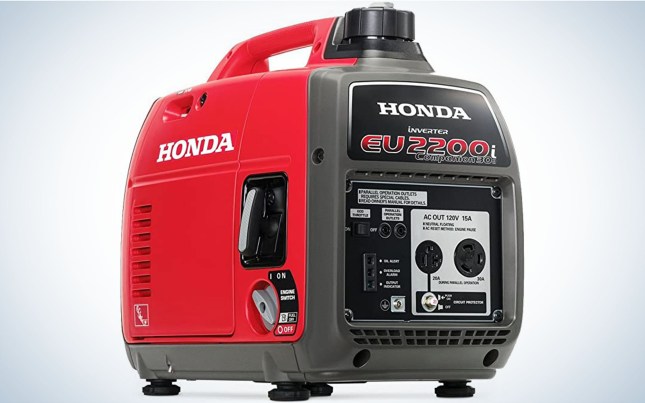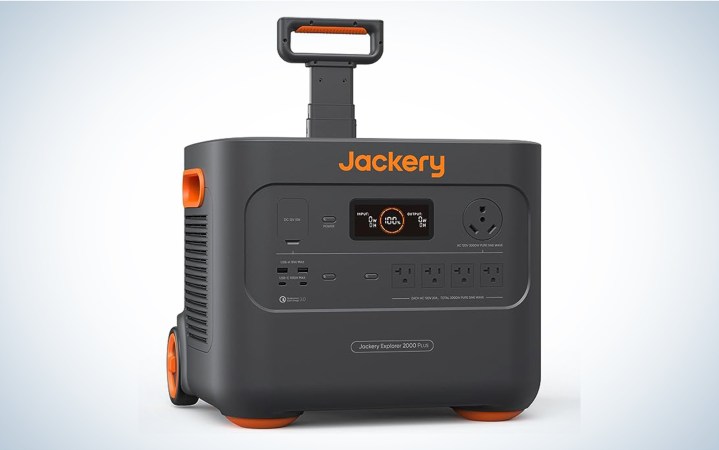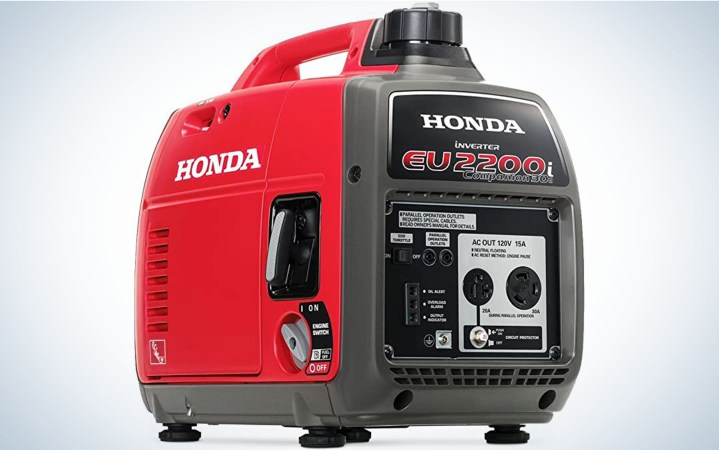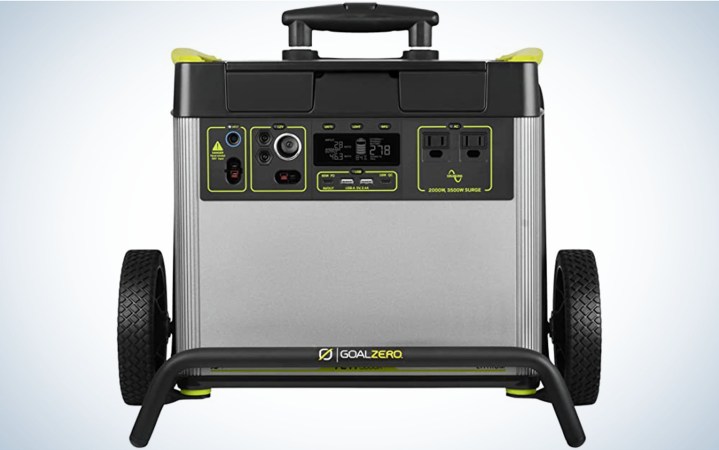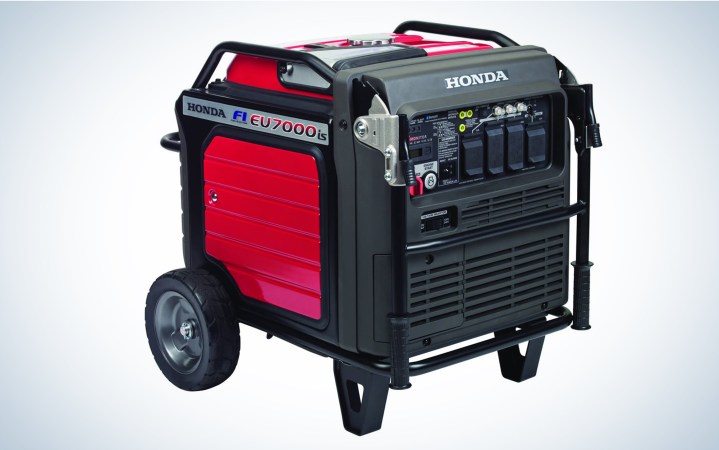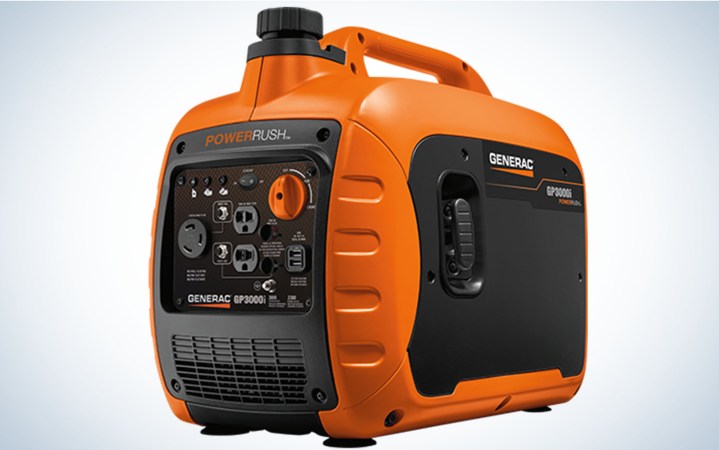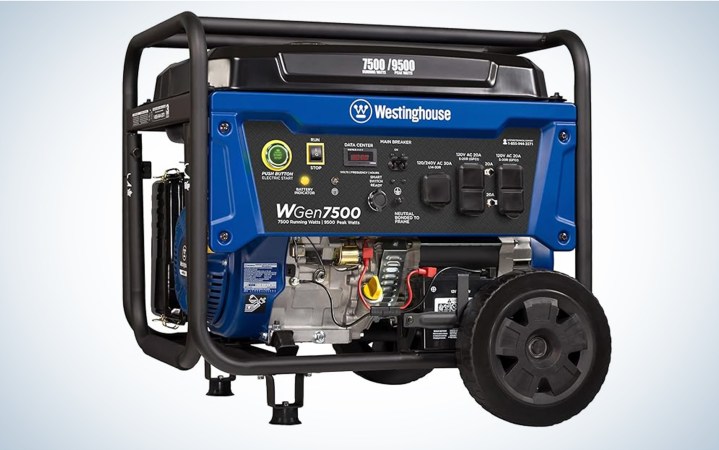We may earn revenue from the products available on this page and participate in affiliate programs. Learn More ›
RV generators are a major investment, and choosing a reliable one is essential to enjoying your rig when you’re off the grid. It used to be that that meant gas, or maybe a dual-fuel generator, but in recent years battery-powered power stations and solar generators have begun to approach the power consumption of some RV campers. Which one is right for you will depend on a number of factors, including what appliances you are trying to power, your budget, the number of days you plan to be off grid for, and your tolerance for noise. Below, I dive deep into the power considerations for the best RV generators to help you make the right choice for your needs.
- Best Solar Generator: Jackery Solar Generator 2000 Plus
- Best Lightweight: Honda EU2200IC Companion Portable Generator
- Best Power Station: Goal Zero Yeti 3000X
- Best Inverter Generator: Honda EU7000is
- Best Budget: Generac 7129 GP3000i
- Best High Capacity: Westinghouse WGen7500
Determining Your Power Needs
Before choosing one of the best RV generators, you first need to determine what your power needs are. These can vary considerably, depending on your setup. To start, here are a couple of major considerations to have front of mind:
- Is your RV working off of a 12 volt DC system? This is very common for RVs, as 12 volt systems are typically more efficient. In these instances, you’re going to want to pay special attention to the amperage of your RV generator.
- Are you planning to run an air conditioning unit? These things are energy hogs, so if yes, plan on a bigger (and more expensive) unit.
Amperage
Amps are the speed at which electricity is flowing out of your generator. The number of potential amps that you need from your generator depends on the cumulative needs of the appliances you plan to use in tandem. For instance, if you plan to use one appliance that needs 30 amps and one appliance that needs 15 amps in tandem, you’ll need a generator that’s capable of handling 45 amps. But if you’ll always be using those appliances one at a time, the most you’ll need is 30 amps.
Volts
Voltage is essentially the pressure at which electricity is flowing out of your generator. You’ll need to find out the highest voltage you need in your RV before choosing a generator. Lots of RVs run off of 12 volt DC systems, but you may have an appliance or two, such as your microwave or air conditioner, that needs more (typically 120 volts in AC).
Time
The length of time that you plan to run your appliances for will impact how large of a generator you need, and whether you should stick with traditional fuel generators or if you can transition to one of the best solar generators. This is typically expressed in watt hours. To determine your watt hour needs, you can use the following equation:
- Amps x hours = Amp hours
- Amp hours x volts = watt hours
So, if you plan to use a 30 amp appliance for two hours, that’s 60 amp hours. If that appliance requires 12 volts, that will be 720 watt hours. If you plan to use a 20 amp appliance for a half hour, that’s 10 amp hours. For an appliance that uses 12 volts, that would be 120 watt hours.
Again, running an air conditioner for a long period of time will result in major power consumption. An AC unit typically uses about 15 amps (not including the startup amps) on 120 volts. If you ran one for four hours, that would use up 7,200Wh.
How I Chose the Best RV Generators
The picks in this story are based on testing and research I and other Outdoor Life contributors conducted on the best solar generators, the best inverter generators, best gas generators, and the best portable generators. The table below provides a comparative side by side look at their warranties, weight, price, electrical capabilities, and more. The below buying guide on the best RV generators provides additional detail on the capabilities and user experience of each of these units.
| Generator | Cost | Weight | Warranty | Fuel Type | Capacity | Max Volts | Max Amps | Decibels |
| Honda EU7000is | $6,000 | 263.2 pounds | 3 years | Gas | 5.1 gallons; 22,000 Wh | 240 | 58.3 | 58 dBA |
| Jackery Solar Generator 2000 Plus | $3,300 | 61.5 pounds (generator only) | 5 years | Solar or electric outlet | 2,042Wh | 120 | 45 | N/A |
| Goal Zero Yeti 3000X | $2,800 | 69.8 pounds | 2 years | Solar or electric outlet | 3,032Wh | 120 | 280 | N/A |
| Honda EU2200IC | $1,300 | 46.5 pounds | 3 years | Gas | 14 ounces; 5,760 Wh | 120 | 50 | 57 dBA |
| Generac 7129 GP3000i | $1,000 | 59.6 pounds | 90 days | Gas | 5 gallons; 5,175 Wh | 120 | 19.1 | 66 dBA |
| Westinghouse WGen7500 | $1,049 | 196 pounds | 3 years | Gas | 6.6 gallons 41,250Wh | 240 | 79 | 72 dBA |
Best RV Generators: Reviews & Recommendations
Best Solar Generator: Jackery Solar Generator 2000 Plus
Best Solar Generator
Jackery Solar Generator 2000 Plus
Key Features
- Weight: 61.5 pounds
- Capacity: 2,042 Wh
- Max Voltage: 120
- Max Amps: 45
Pros
- Easy, intuitive power station interface
- Comes with best-in-class solar panels
Cons
- Heavy
- Expensive
If you’re already a fan of Jackery’s simple and intuitive power stations then pairing their Explorer 2000 Plus with one of the best in-class solar panels for camping, the SolarSaga 200W, is a no-brainer. Not only does this power station feature a plug for an RV, allowing you to easily power all those 12V appliances, it also stores enough energy to power the average setup for a day. If you’ve been looking to upgrade to a quieter generator for camping, then this is an easy choice.
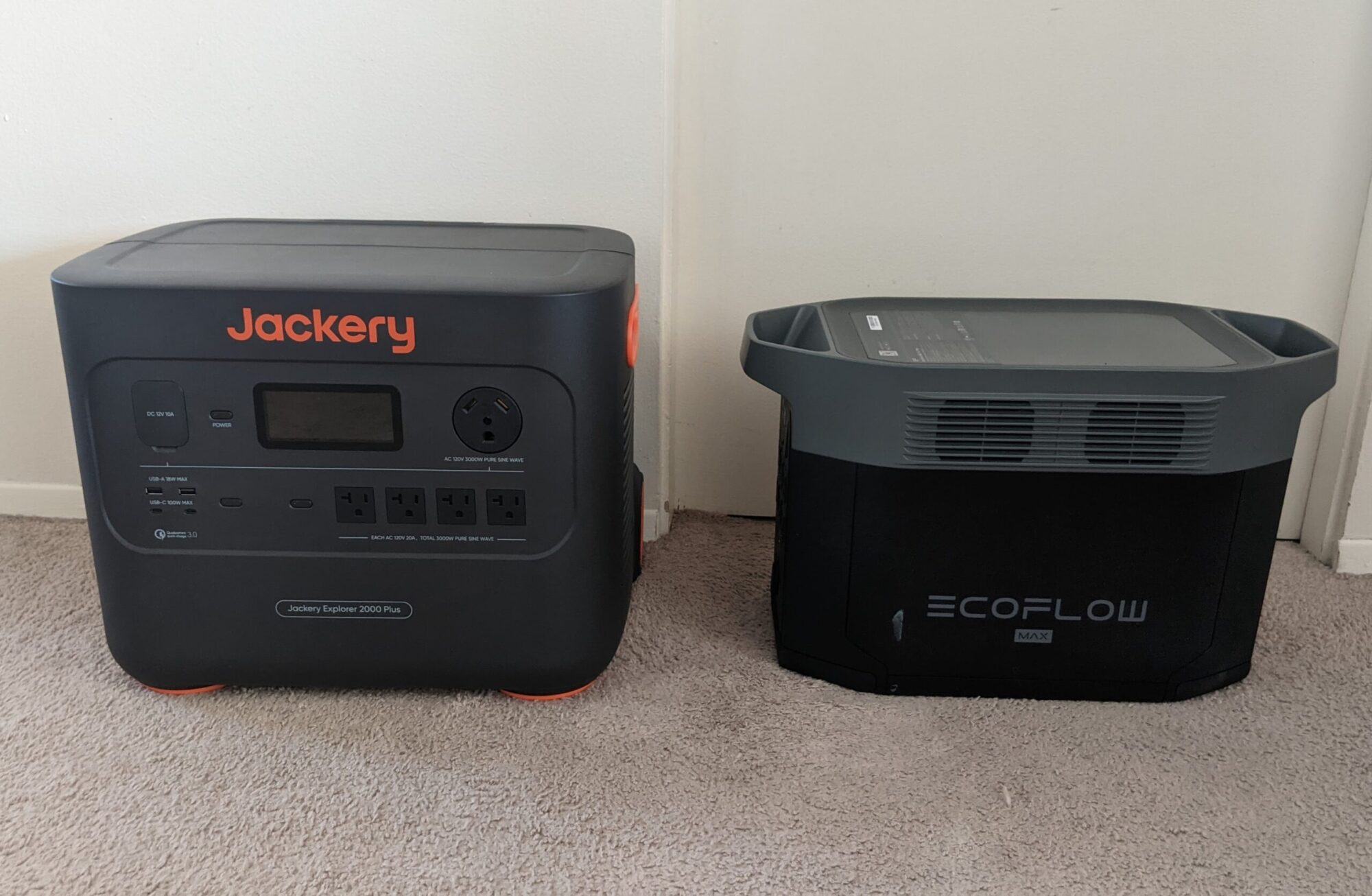
During testing, the size and weight of the Jackery Explorer 2000 Plus was sometimes an issue for me, a woman on the smaller side. If you have back problems and don’t need this kind of power, I suggest looking elsewhere. While there is a handy telescoping handle that allows you to pull it over flat distances fairly easily, you’ll likely still need to pick it up periodically to get it into your car. The telescoping handle was also so short that I sometimes had to lean over when pulling it along.
I originally tested the SolarSaga 200W solar panel as a full setup, with four panels plugged into a single power station. This test showed the full power of the array, which registered 650 watts of power generation on a sunny (albeit hazy) day. I retested a single panel in tandem with the rest of the units in this review more recently, and under completely clear skies, the panel was even more impressive: It registered 184 watts of energy coming from a single panel. If you don’t have much time to recharge your power station from the sun, then the full setup with all four panels is a no-brainer. (More recent testing of newer panels showed a slight drop in power; however, it is unclear if this is because of natural variation or drop in the product’s efficiency. Either way, this is still a best-in-class panel.)
It is, though, a little complicated. Each panel comes with a carrying case and a cable that connects back to the two DC ports on the Explorer 1000 Pro. If you see a math problem here, that’s correct: You’ll also need two of the Jackery Solar Panel Connectors, which, strangely, are not included in the purchase price. Two of these can be used to double the number of panels you can connect to the Explorer 1000 Pro.
Setting up and taking down this many panels takes some time, but I was impressed by how easy and intuitive it was. That’s because Jackery streamlined the number of ports on each unit, making it that much clearer what cable connects to what unit in what port.
While at first glance there might appear to be a disconnect between the charging time capabilities of this setup and its battery life, it’s worth keeping in mind that conditions are not always optimal. One of the things that impressed me most about these units is the panel’s ability to generate electricity in lowlight conditions. Even in complete shade—dusk fast approaching—a single SolarSaga 200W was generating a 6 watt input.
Best Lightweight: Honda EU2200IC Companion Portable Generator
Best Lightweight
Honda EU2200IC Companion Portable Generator
Key Features
- Weight: 46.5 pounds
- Capacity: 14 ounces; 5,760Wh
- Max Voltage: 120
- Max Amps: 50
Pros
- Lightweight
- Affordable
Cons
- Smaller capacity than large gas generators
Gas generators have long been a mainstay of the RV crowd. In his roundup of the best gas generators, Andrew Waite called out the Honda EU2200IC as one of the more lightweight and portable options around, particularly useful for RV campers with smaller rigs where they might need to physically lift the unit when setting up at a new boondock site. Here’s what he had to say: “Like the WEN, this Honda portable generator is also a small generator. At about 21 x 12 x 20, it’ll easily fit in the trunk or truck bed. It’s also a quiet generator, emitting 57dBA at a full load and just 48dBA at a quarter load. The running wattage is 1,800, and 0.95 gallons of fuel can generate up to 8.1 hours of runtime at a quarter load––enough for the entire workday at the construction site.”
Best Power Station: Goal Zero Yeti 3000X
Best Power Station
Goal Zero Yeti 3000X
Key Features
- Weight: 69.8 pounds
- Capacity: 3,032 Wh
- Max Voltage: 120
- Max Amps: 280
Pros
- Durable exterior
- Lots of information on your power use
Cons
- Less intuitive than other power stations I looked at
The Goal Zero Yeti series is a powerful, durable line of power stations that provide some of the most in-depth information of any power station I’ve looked at, giving RV campers a lot of information about their power use. However, it also has one of the most complicated user interfaces to navigate (I tested the Goal Zero Yeti 1500X as part of my test of the best solar generators). To start, when the unit is plugged into a power source, a light blinks blue continuously until it is charged; then it switches to solid blue. If you are in the same space as this unit when it is charging, this is very distracting.
Next is the three buttons above the display—which read “unit,” “light,” and “info.” Unit is fairly straightforward—it toggles the input and output measurements between volts, amperes, watts, etc. This is pretty handy if you’re curious about how much power a given device is chewing through. Next is light—on other power stations, this button turns on an actual light, which is useful if you’re trying to see what you’re doing in the evening hours. The Goal Zero, however, does not have a built-in light. This button turns on and off the display screen showing the power supply. The info button only seemed to turn on the display (not off)—it was unclear what other use this was meant to have.
Interestingly, despite having one of the most powerful AC ports in my test (2000W with a 3500W surge), there was only space for two plug-ins. Most of the time, I suspect this will be plenty for people (and it does help to cut down on the unnecessary juice being lost out of these ports), but others might find themselves digging out a powerstrip to make up for the lack of ports.
One of the more unusual features of the Yeti 1500X is a top lid, which has storage for charging cables, or anything else you want to throw in there. This proved to be surprisingly useful while camping, when stray cables can go missing with surprising regularity.
Underneath, it also has detailed descriptions of all of the power limitations of the various ports, plus evergreen reminders about not letting your power station get wet—all in semi-legible font. Surprisingly that can’t be said for any of the power stations in my test (including the Anker SOLIX F2000, which despite having the largest surface area strangely didn’t include this information at all). There is also a second 8mm port under the lid as well as a 12 volt HPP output port.
A testament to Yeti’s claim of 1,500 watts of power was my ability to actually charge the Anker SOLIX F2000 using the Yeti generator. It supplied 1,385 watts through a single AC port, which was higher than anything else I tested, partly due to this being the only combination where that was available. The maximum input capability of the Yeti 1500X is 150V from AC power, and no unit is capable of that many volts. The icon showing how much power was remaining did stay consistent.
Best Inverter Generator: Honda EU7000is
Best Inverter Generator
Honda EU7000is
Key Features
- Weight: 263.2 pounds
- Capacity: 5.1 gallons; 22,000Wh
- Max Voltage: 240
- Max Amps: 58.3
Pros
- Extremely reliable and well-built
- Quiet and efficient gas-powered engine
Cons
- Expensive, even for its size
- Heavy
When you need to fire up your generator, the only thing worse than it failing to start is finding out that it can’t produce adequate power. With the Honda EU7000is, you should never have to worry about either of those problems. Honda’s small engines are just as reliable as the brand’s cars, and this home backup generator is strong enough to power multiple appliances or your RV.
The 389cc engine generates 5,500 running watts and 7,000 surge watts. Using fuel injection instead of a carburetor, it can run for 16 hours on the 5.1-gallon tank at a 25 percent load. You’ll be able to power things like a full-size refrigerator, a gas- or oil-burning furnace (yep, those still need electricity), and lights. The EU7000is has wheels, but you’ll still want to keep it on paved surfaces because it weighs 263 pounds.
Aside from the workout of rolling this generator out of the garage and into the driveway, Honda made it very user-friendly. You can start it with the push of a button, control it with an app, and monitor its fuel level with a gauge instead of opening the tank every time. Safety features like circuit breakers, GFCI outlets, automatic carbon monoxide shutoff, and warning lights take the stress out of using this generator.
The EU7000is is a significant investment even before wiring your house for it, and it’s even more expensive than a lot of comparably sized inverter generators. But it’s also built to an incredibly high standard and comes with a bunch of features that make it easy to use. In the long run, you’ll be glad you spent a little extra. If you really want to set yourself up right, buy this for your home or RV and something small like the Jackery Explorer 300 for life on the go. —Alan Clemmons
Best Budget: Generac GP3000i
Best Budget
Generac GP3000i
Key Features
- Weight: 59.6 pounds
- Capacity: 5 gallons, 5,175 Wh
- Max Voltage: 120
- Max Amps: 19.1
Pros
- Quiet operation
- Can run in parallel with another GP3000i for double the power
- Safe to use with sensitive electronics
- Best for powering select appliances or a campsite
Cons
- Can be cumbersome to carry, especially with a full tank
- Underpowered for home backup
The Generac GP 3000i is a versatile inverter generator that’s perfect for powering a few electronics while you’re RV camping. It’s light enough for one person to carry, but still powerful enough to handle certain appliances in addition to your personal electronics. When my neighborhood lost electricity for a few days one summer, I used a GP3000i to run my chest freezer long enough to save about a hundred pounds of meat from spoiling.
The heart of this inverter generator is a 149cc engine that generates 2,300 running watts and 3,000 surge watts. Its 1.06-gallon tank will run the engine at 50 percent capacity for 4.5 hours. One person can move this 60-pound generator by its carrying handle, but it can be a little cumbersome. Plan on storing it someplace where you don’t have to carry it very far to use it. The system is simple and reliable, but Generac includes a three-year residential use warranty, just in case.
Using the Generac GP3000i is simple and straightforward. Start-up and shut-down graphic instructions are clearly printed on the top of the housing. The pull starter is more labor-intensive than electric ignition, but it’s incredibly reliable and doesn’t require much effort. Even after sitting idle for months at a time, my GP 3000i starts within three or four pulls. A clearly marked dial switches between choke (for cold starts), run, and off. You can let the engine idle at a constant speed or switch on the economy mode to let it raise or lower engine speed to match the power demand from the outlets.
The GP 3000i is a little bit underpowered for home backup, but my experience proves that it can power select appliances in an emergency. Around the campsite, it’s just right. Having multiple outlet types—including two USB ports—makes it great for charging everything from a pellet smoker to your phone at the same time. —Scott Murdock
Best High Capacity: Westinghouse WGen7500
Best High Capacity
Westinghouse WGen7500
Key Features
- Weight: 196 pounds
- Capacity: 6.6 gallons; 41,250Wh
- Max Voltage: 240
- Max Amps: 79
Pros
- Digital readout of run time, voltage, and other critical data while in use
- Supports 30A transfer switch for home use
- Weighs less than 200 pounds and can be moved easily thanks to durable wheels and design
Cons
- Smart switch to help operate home appliances is sold separately
Westinghouse WGen7500 is a compact engine designed to power critical needs. It has a 420cc four-stroke engine with an air-cooled overhead valve design for more efficient operation. The automatic low-oil shutdown technology protects the engine when low oil level is detected, saving the engine from damage. It also meets EPA and CARB emission standards, which is better for the environment. The push-button key fob starter allows you to get the generator operational from up to 260 feet away.
When you need a durable, efficient portable gas generator but don’t need a monster, this model should be a consideration. It’s well designed with numerous features for home or camp use, and relatively easy to load on a trailer or in a truck bed. The easy digital readout is solid for keeping up with run times, fuel, and oil levels, and updates for maintenance. —Alan Clemmons
Things to Consider Before Buying an RV Generator
Fuel Source
One of the biggest decisions you’ll need to make when choosing an RV generator is what kind of fuel you’ll want to use. There are pros and cons to the various options. Solar can work for individuals in especially sunny climes and have more limited power needs (no air conditioning unit). Individuals who will only be away from a hookup for a day or so at a time can also get away with simply charging their unit up when they have power and using it without any kind of a solar boost.
But if you plan to be off grid for days at a time, then you’ll want to ensure you have access to enough power to keep your RV going. In these instances, fuel-powered generators can be a great, if loud, option. Keep in mind that while some traditional generators run only on gas, others also run on either propane or natural gas, or sometimes all three.
Cost
RV generators, especially solar generators, can run thousands if not tens of thousands of dollars. For many people this is a serious investment. Spend the time and do the research to make sure you are making the right choice. When possible take advantage of resources offered by the manufacturers to better understand if the RV generator you are considering is powerful enough (or too powerful) for your needs.
Noise
RV generators can vary in the level of noise they produce, from being so loud as to make conversation difficult if not impossible to virtually silent. If you plan to only run your generator while cooking or for limited times during the day, noise might not be an issue. However, if you plan to run your RV generator for extended periods of time this could become a determining factor.
Weight
Some RV generators are light enough that they can be moved by virtually any adult; some are distinctly two-person (or more) jobs. If you will need to move your RV generator on a semi-regular basis, then keep an eye on the weight.
Maintenance
All RV generators will need to be taken care of, but expect fuel-based RV generators to require more maintenance and care than electric models.
FAQs
The size generator that is best for RVs will depend on your electrical needs, especially if you plan to run an air conditioning unit.
A 3,500 watt generator should run an RV air conditioner, but double-check the voltage (typically needs to be 120 volts) and the ampere to confirm.
The best way to determine this is to consider what the most power hungry appliances you plan to use in tandem are, and then look to see what their ampere requirements are.
Why Trust Outdoor Life?
Since 1898, OL has been a leading authority in testing and reviewing hunting gear, fishing tackle, guns and shooting equipment, and much more. We have more than a century-long history of evaluating products, and we’re now bringing that expertise to online reviews. Our editors are experienced outdoorsmen and women, and most importantly, we’re trained journalists. We prioritize field testing and objective data when reviewing products. We conduct interviews with gear manufacturers and engineers as well as outdoor experts so that our readers have an understanding of how and why a product works—or doesn’t.
Advertising does not influence our gear reviews and it never will. While we always focus our coverage on standout products—because we want our readers to be aware of the latest and greatest gear—we also cover the flaws and quirks of any given product.
Final Thoughts
Picking the best RV generator for you will depend on your energy needs and the amount of time that you expect to be off grid. It’s also a major investment. When in doubt, consult a technical expert at the company you are considering purchasing from to learn more information.
- Best Solar Generator: Jackery Solar Generator 2000 Plus
- Best Lightweight: Honda EU2200IC Companion Portable Generator
- Best Power Station: Goal Zero Yeti 3000X
- Best Inverter Generator: Honda EU7000is
- Best Budget: Generac 7129 GP3000i
- Best High Capacity: Westinghouse WGen7500
